21.5-inch iMac (Late 2013) Review: Iris Pro Driving an Accurate Display
by Anand Lal Shimpi on October 7, 2013 3:28 AM ESTCPU Performance
I ran the entry level iMac through our normal OS X CPU test suite. I don't have a ton of Mac desktops in the database but I do have results for last year's 27-inch iMac that'll help put things in perspective. Also keep in mind that the 21.5-inch iMac came equipped with a HDD, while nearly everything else I'm comparing it to has an SSD inside.
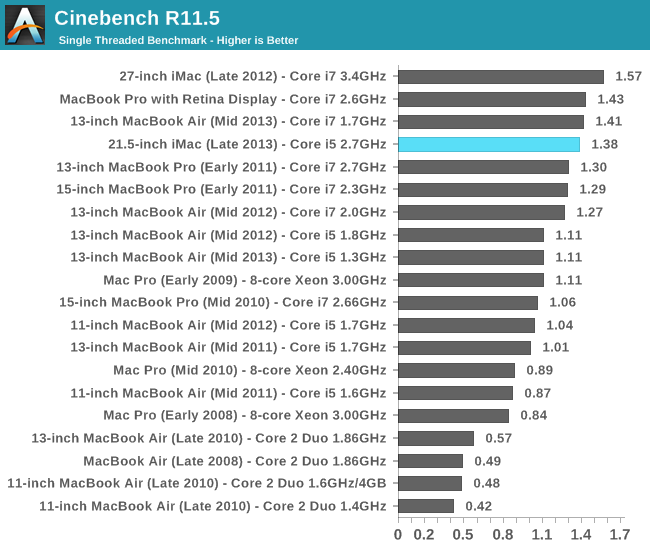
Single threaded performance is about on par with an upgraded 13-inch Haswell MacBook Air, which is sort of insane when you think about it. The Core i7 upgrade in the 13-inch MBA can turbo up to 3.3GHz, compared to 3.2GHz with the entry-level iMac’s Core i5. The amount of L3 cache dedicated to a single core is actually the same between both parts (at 4MB). In the case of Cinebench, the 128MB L4 cache doesn’t seem to do much.

Multithreaded performance is obviously much better than what you’d get from a MacBook Air. You’ll notice the entry-level iMac’s performance here is actually quite similar to that of my old 2011 15-inch MacBook Pro. Although the Core i5-4570R has higher IPC and more TDP to work with, since it’s a desktop Core i5 it doesn’t support Hyper Threading and thus is only a 4 core/4 thread part. The Core i7 in my old MBP however is a 4 core/8 thread part, letting it make better use of each core’s execution resources in heavily threaded applications. This is really no fault of Apple’s, but rather a frustrating side effect of Intel’s SKU segmentation strategy.
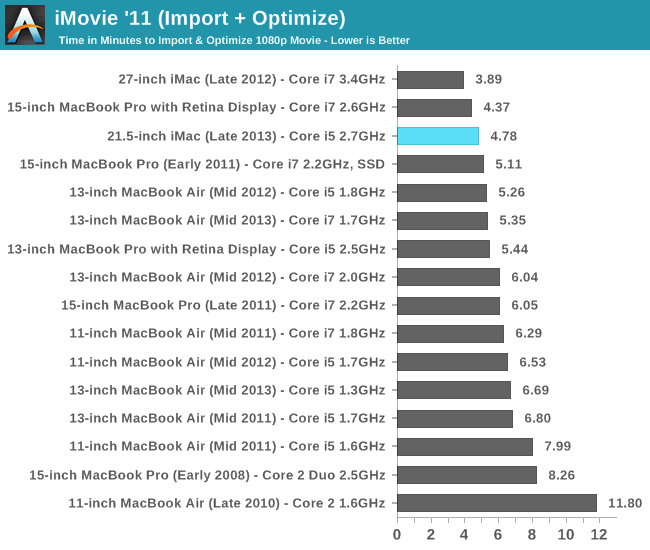
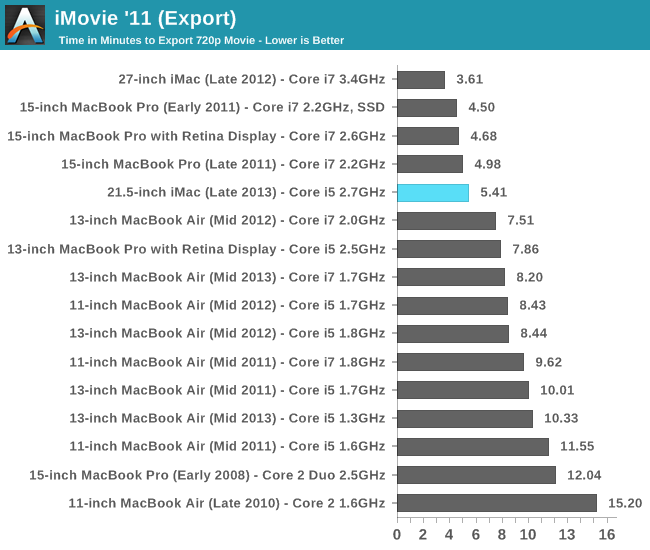
Looking at our iMovie test we see another 50% advantage comparing last year’s highest end 27-inch iMac configuration to the entry-level 21.5-inch model. The explanation boils down to lower max turbo frequencies and fewer number of simultaneous threads supported. There’s also the fact that I’m testing a HDD equipped system and comparing it to those with SSDs, but most of my OS X CPU test suite ends up being largely CPU bound with minimal impact from IO performance.
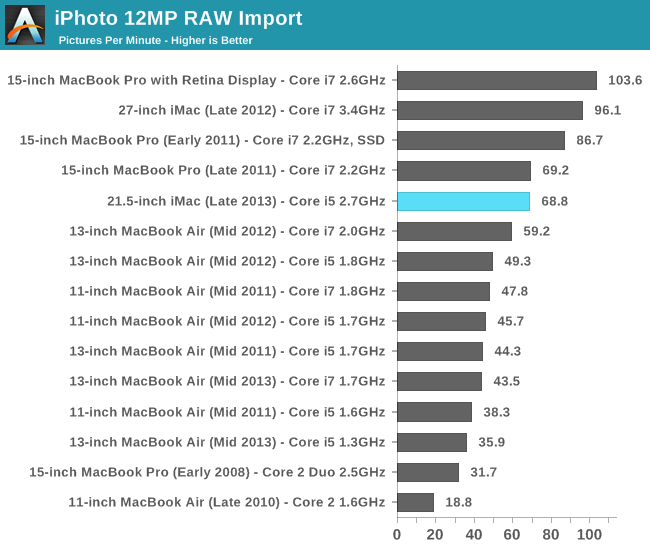
iPhoto import performance runs pretty much in line with what we’ve seen thus far. The entry-level iMac is a good performer, but power users will definitely want to push for a faster CPU.
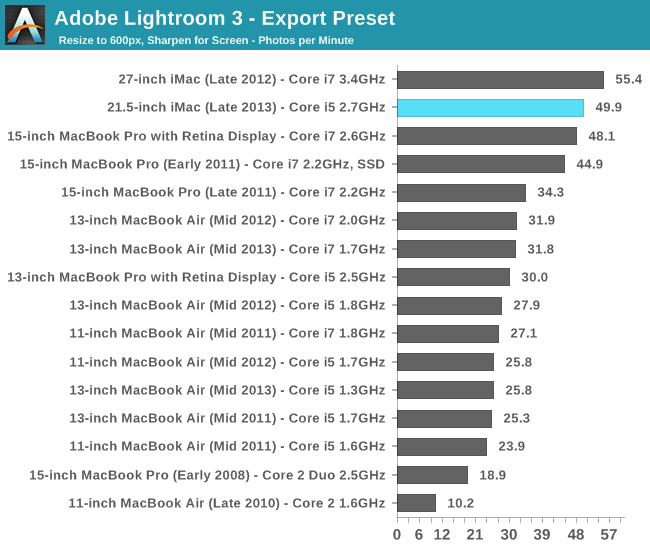
Our Lightroom export test is perhaps the most interesting here. The gap between last year’s 3.4GHz Core i7 and the Crystalwell equipped Core i5-4570R is only 12%. My first thought was to attribute the difference to Crystalwell, but if we look at the gap vs. the 1.7GHz 2013 MacBook Air the iMac’s advantage isn’t really any different than under our iPhoto test. Instead what I believe we’re seeing here is yet another benchmark where Haswell’s architectural advantages shine.
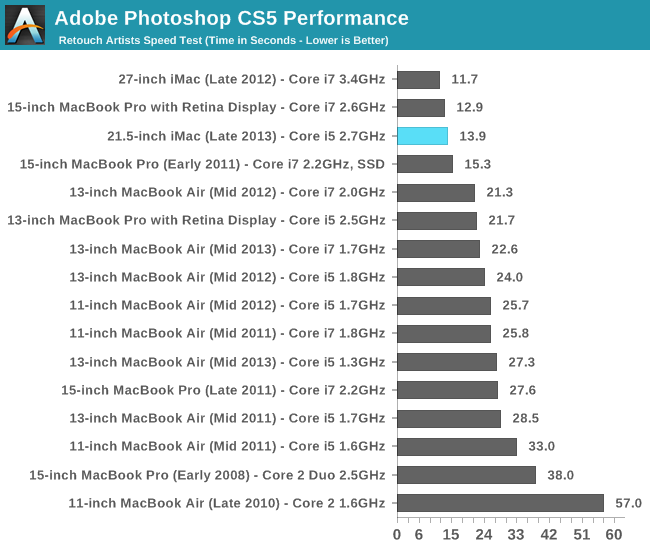
Performance in our Photoshop test is similarly good, with the entry-level iMac coming relatively close (within 20%) to the performance of a high-end 2012 27-inch iMac.
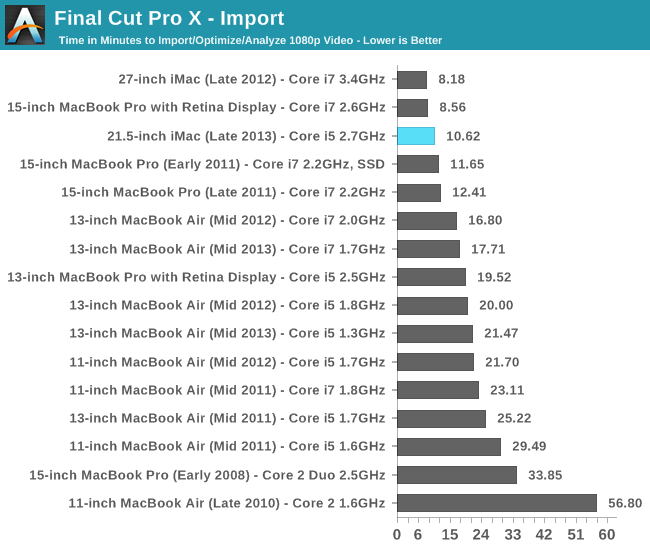
There aren’t any surprises in our FCP-X test either.
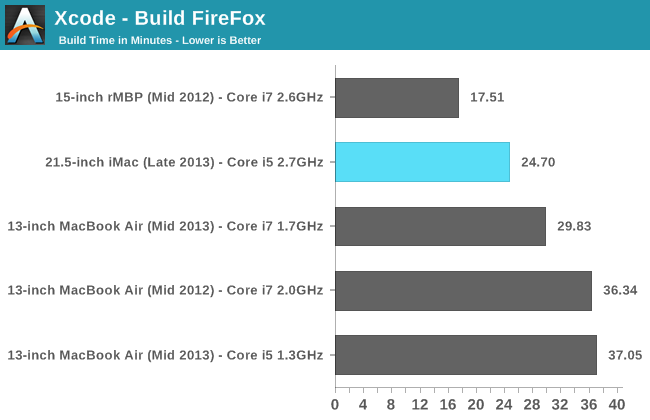
I'm slowly amassing results in our Xcode test. What's interesting about the 21.5-inch iMac's performance here is just how inconsistent it was due to the HDD. Subsequent runs either gave me similar performance to what I'm reporting here, or much, much higher build times. If you needed a reason to opt for an SSD, this is a great one. Even looking at the best performance the iMac can deliver, you can see it's not tremendously quicker than the MacBook Air. With an SSD I'd expect to see far better numbers here.










127 Comments
View All Comments
g1011999 - Monday, October 7, 2013 - link
Finally. I check anandtech several times recently for Iris Pro based iMac 21" review.malcolmcraft - Thursday, October 9, 2014 - link
It's nice, I agree. But for a full-size work station I'd not recommend Mac. /Malcolm from http://www.consumertop.com/best-desktop-guide/Shivansps - Monday, October 7, 2013 - link
I suspecting that the big loss in performance on high details compared to 750M may be related to L4 eDRAM running short than driver issue, as AA, Intel never had good performance with filters, they support hardware x2 AA yet?tipoo - Monday, October 7, 2013 - link
Yeah, doesn't AA hammer bandwidth? The eDRAM helps performance, but it's still quite low compared to what the other cards are paired with, even in best case scenarios.IntelUser2000 - Tuesday, November 12, 2013 - link
I don't think its just that. Compared to the competition like the Trinity's iGPU and the GT 650M, the texture fill rate is rather low. That impacts performance not only in texture bound scenarios with settings cranked up but anti-aliasing as well. The fillrate of the top of the line Iris Pro 5200 is about equal to Trinity while the version in the iMac would fall short. The GT 650M is 40% better than the top of the line Iris Pro and over 55% better than iMac version.There's also something to be desired about Intel's AA implementation. Hopefully Broadwell improves on this.
IanCutress - Monday, October 7, 2013 - link
Interestingly we see Crystalwell not have any effect on CPU benchmarks, although we can probe latency as seen before.willis936 - Monday, October 7, 2013 - link
This seems counter intuitive. It's acting as a CPU+GPU shared cache correct? Intel architectures are relatively cache bandwidth starved and you'd think that 128MB of L4 would help keep the lower levels filled.Flunk - Monday, October 7, 2013 - link
Perhaps it means that the assumption that Intel architectures are relatively cache bandwidth starved is faulty.name99 - Monday, October 7, 2013 - link
Or that the working set of most benchmarks (if not most apps) is captured with a 4 or 6MB cache?Caching's basically irrelevant for data that is streamed through.
tipoo - Thursday, October 10, 2013 - link
The L4 is pretty low bandwidth for a cache though.